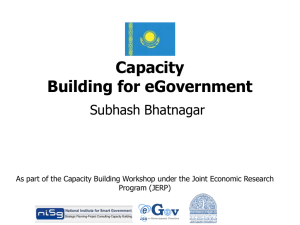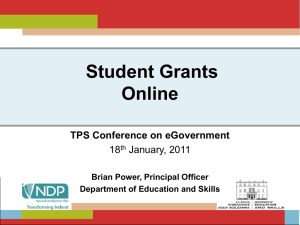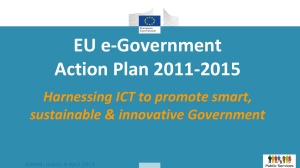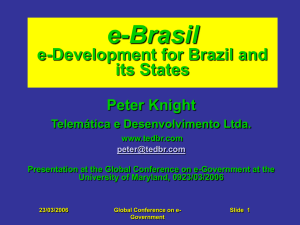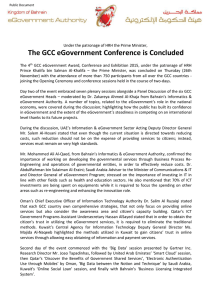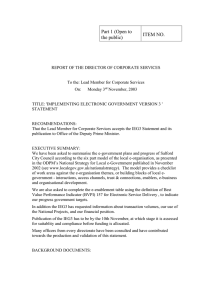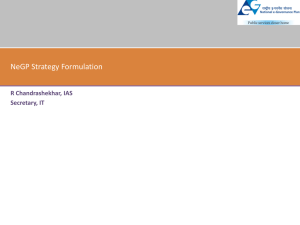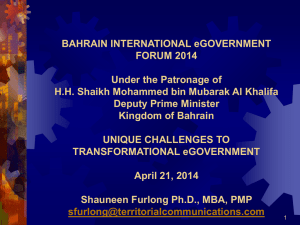Conference summary
advertisement
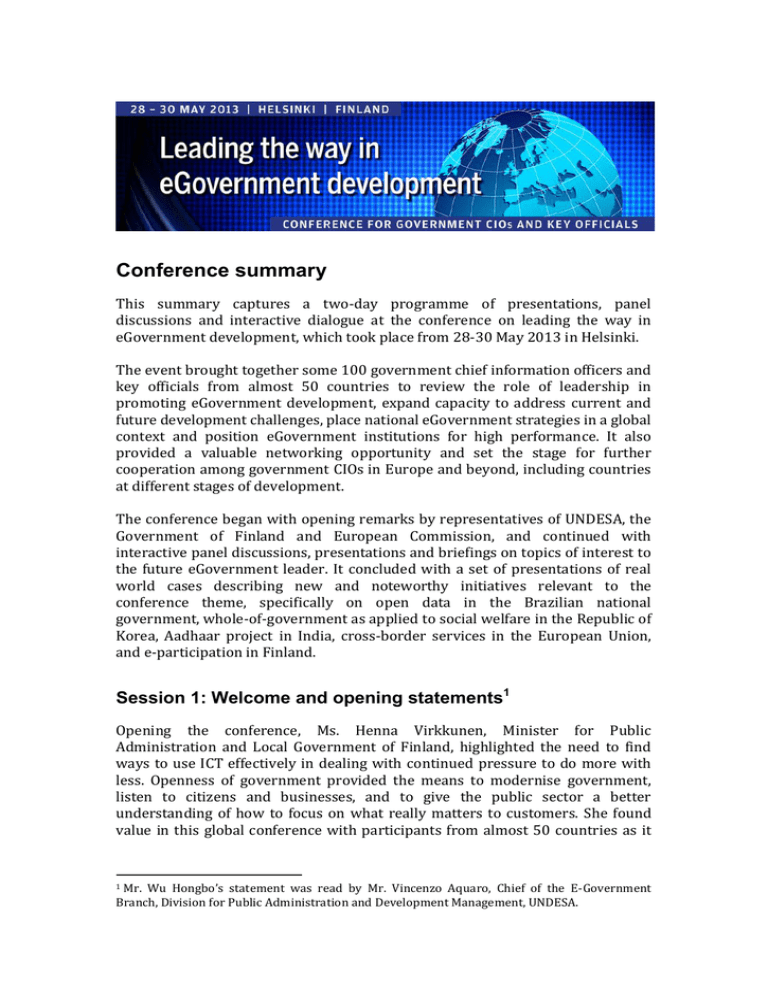
Conference summary This summary captures a two-day programme of presentations, panel discussions and interactive dialogue at the conference on leading the way in eGovernment development, which took place from 28-30 May 2013 in Helsinki. The event brought together some 100 government chief information officers and key officials from almost 50 countries to review the role of leadership in promoting eGovernment development, expand capacity to address current and future development challenges, place national eGovernment strategies in a global context and position eGovernment institutions for high performance. It also provided a valuable networking opportunity and set the stage for further cooperation among government CIOs in Europe and beyond, including countries at different stages of development. The conference began with opening remarks by representatives of UNDESA, the Government of Finland and European Commission, and continued with interactive panel discussions, presentations and briefings on topics of interest to the future eGovernment leader. It concluded with a set of presentations of real world cases describing new and noteworthy initiatives relevant to the conference theme, specifically on open data in the Brazilian national government, whole-of-government as applied to social welfare in the Republic of Korea, Aadhaar project in India, cross-border services in the European Union, and e-participation in Finland. Session 1: Welcome and opening statements1 Opening the conference, Ms. Henna Virkkunen, Minister for Public Administration and Local Government of Finland, highlighted the need to find ways to use ICT effectively in dealing with continued pressure to do more with less. Openness of government provided the means to modernise government, listen to citizens and businesses, and to give the public sector a better understanding of how to focus on what really matters to customers. She found value in this global conference with participants from almost 50 countries as it Mr. Wu Hongbo’s statement was read by Mr. Vincenzo Aquaro, Chief of the E-Government Branch, Division for Public Administration and Development Management, UNDESA. 1 offered a forum to exchange views and learn from each others’ experiences, especially on such topical issues as balancing data protection and openness. Mr. Wu Hongbo, United Nations Under-Secretary-General for Economic and Social Affairs, noted that as discussions on a post-2015 development agenda gain momentum, countries have an opportunity and a responsibility to ensure that eGovernment contributes to development in meaningful ways. In this connection, he highlighted the need to strengthen eGovernment leadership capacity, expand the scope of eGovernment strategies beyond efficiency considerations and fully utilize ICT as a positive and transformative force for the future. Mr. Paul Timmers, Director of the Sustainable & Secure Society Directorate of DG CONNECT of EC, underscored the growing need for public sector innovation and smart use of ICT, which could also help Europe to overcome the current crisis. Noting the importance that the Commission attaches to public sector innovation, he outlined the EC’s vision of open, transparent and collaborative government, digital-by-default public administration, and integrated cross border public services within the European Union. Session 2: The future eGovernment leader The featured speaker, Mr. Ian Goldin, Professor of Globalisation and Development and Director of the Oxford Martin School, Oxford University, focussed on the transformative power of the Internet in an increasingly wide range of beneficial applications (e.g., e-health, e-education), and its concomitant potential to create and propagate risks. Systemic risk was increasing due to rising interdependence and because the pace of innovation is racing ahead of regulatory and governance process. Such risks could pose a fundamental challenge to national leaders and national and international institutions as evidenced by current concerns about cyber security. In his view, eGovernment provided extraordinary opportunity but also faced real vulnerabilities, which must be recognized and managed to realize and sustain technology’s potential. In particular, attention is needed to be given to closing the digital divide as a matter of some priority in all countries. Without a concerted effort in this regard, uneven access to modern administration could well expand divides, thereby undermining the value of eGovernment to society. Mr. Ian Golding placed overcoming the digital divide as the most important issue governments should address going forward. Second, in terms of importance is systems integrity and robustness especially in terms of trust, security and privacy, given that the abusers are always at our heels. This is closely followed by the fact that the technology changes more rapidly than we can respond to every latest development. Other important priorities include the need to strengthen regulation, for example a global treaty-based security system which is bound to come at some point as it is in all countries interests. Also of prime importance is to highlight and strengthen notions of the global public good, for 2 example through the Millennium Development Goals (MDGs) and the whole-ofgovernment approach, so that global organizations like the UN are extremely important. Session 3: Roles and positioning of national CIOs for performance2 Mr. James Kang, Assistant Chief Executive and Government CIO, Infocomm Development Authority of Singapore, made a presentation in which he noted that “uncertainty is the new normal” and that government CIOs are facing dynamic and complex issues that no one government agency alone could solve. Instead, such issues required the joint attention of many agencies, if not government as a whole. Moreover, collaborative government was needed to address citizens’ rising expectations, which was a feature of the current Singaporean eGovernment master plan. The concept of collaborative government represented a shift from government-for-the-people to government-with-the-people as well as for-thepeople and entailed, among other things, co-creation of social connectivity among government and people. This involved the use of social media, in particular social analytics to support citizen engagement. It implied empowerment through access to information with all government data shared by default unless agencies could provide compelling reasons for not sharing it. It also called for user-friendly interfaces with government websites designed based on citizen-centric usability criteria. Mr. Kang also described the ICT governance structure in Singapore where the Ministry of Finance provides money, mandates and manpower, and the Infocomm Development Authority acts as CIO to government agencies and as a catalyst for public sector transformation. The panel discussion that followed was guided by questions posed by the Chairperson, Mr. Reinhard Posch, Government CIO, Austria. Mr. Posch began by asking whether the role of the government CIO was that of a policy driver or more a leader in implementation of new technologies. Related to this question was an assessment of the government CIO’s core competences and added value. There was much agreement among panellists that technology was the least of problems in eGovernment development. A bigger challenge lay in effectively managing people and organizational change, and in understanding the business and the world we are in. Capacity for innovation was often regarded as a core competency of the government CIO, who was often called upon to make creative Session 3 was chaired by Mr. Reinhard Posch, Government CIO of Austria. Panellists included Mr. James Kang, Assistant Chief Executive and Government CIO, Infocomm Development Authority of Singapore, Mr. Javier Torres, High Advisor on CIO’s strategies and implementation of Colombia, Mr. Peter Batt, Deputy CIO, Federal Ministry of the Interior of Germany, and Mr. Wim Sijstermans, Government CTO of the Netherlands. 2 3 use of limited resources, effectively lead collaborative networks and engage with citizens in addressing evolving needs. The critical role of government CIO as a change agent was highlighted with ability to build trust and flexibility and effectively work in a multi-dimensional and multi-level environment. It was stressed that Government CIOs should be leaders who understand how ICT transforms government, and how to sustain the transformation. In this connection, particular attention was drawn to the role of joined-up leadership and how it could be framed institutionally. With respect to added value of the government CIO, exercising leadership, creating IT strategy with commitment from other CIOs and acting as a symbol of ICT for the outside world, were highlighted. Government CIOs should demonstrate leadership in uncharted areas and have a clear plan, which needed to be well communicated. Another important guiding question was whether the trend in institutional positioning of eGovernment authorities was more in the direction of centralization or decentralization. Much emphasis was placed on finding a balance of centralization and decentralization. Recent initiatives were noted, such as an article in the German constitution that called for coordination at all levels of government including with regard to infrastructure, interoperability standards and promotion of new projects. In the Netherlands, eGovernment authority was more centralized at the national, government-as-a-whole level, with efforts being undertaken to expand shared services. However, there were also many local governments. A CIO council served as a mechanism for reaching consensus and agreement on eGovernment priorities across and among these levels. Knowing what to centralize and decentralize was considered important. It was suggested as a rule of thumb that whatever could be accomplished by individual agencies should be done by them to encourage innovation and initiative. Certain activities would need to be centralized such as national identity management, security and interoperability standards. Each government would need to decide on an appropriate distribution of authority. 4 Session 4: Demonstrating the benefits of eGovernment services3 The discussion and presentations underscored the importance of a citizencentred approach. Government officials was highlighted as important to effectively communicate with citizens, thereby demonstrating the benefits of eGovernment and also working in partnership with citizens, listening to and learning from them. Citizens often knew that they benefit from eServices with respect to time and cost-savings. For example, it was estimated that citizens save one week of time every year by using digital signatures in Estonia. The best eServices require less work from the citizens than traditional services. Ways of increasing eGovernment benefits and key enablers included eID, eDocuments, authentic sources, eSafe, a life event service model and an enterprise architecture approach. Government can provide the best service for citizens and ease their work by integrating the back-office, sharing systems and providing a single point of entry. In federal government structures in countries such as Belgium, effective service integration was deemed to be particularly important in terms of cost-savings and efficiency achieved through an integrated approach and improved interoperability including a common interoperability platform. Use of open source tools was warranted, as it could help contain costs. Specific benefits in Belgium had included administrative simplification and faster processing of tax refunds. Strong evidence of eGovernment benefits was provided by the Japanese experience. The country had set a 20% cost reduction target for government administration through eGovernment initiatives. Tremendous benefits had indeed been achieved through e-procurement, transparency and going paperless. As an example, during the tsunami many local governments had lost official documents, the exception being those that enhanced disaster resilience by embracing eGovernment. Notwithstanding these benefits, justification for additional budgets for eGovernment initiatives still remained a challenge. While there was strong evidence of benefits of eGovernment initiatives, there were several challenges associated with demonstrating them to policy-makers. At the most fundamental level, there was the challenge of measuring the benefits of e-services. Scientific findings concerning the benefits of eServices were weak. Session 4 was chaired by Mr. Paul Timmers, Director of the Sustainable & Secure Society, DG CONNECT, EC. Panelists included Mr. Hendrik Bogaert, Secretary of State for Civil Service and Modernisation of Public Services, Belgium, Mr. Tomi Dahlberg, Senior Researcher, University of Turku, Finland, Mr. João Ricardo Vasconcelos, Foreign Affairs Coordinator, Agency for Public Services Reform, Portugal, Ms. Johanna Pimiento Quinter, Director, Government Online, Ministry of Information and Communications Technology, Colombia, and Mr. Toshio Obi, Professor and Director of Institute of eGovernment, Waseda University and Chair of National e-Government Promotion, Japan. 3 5 Most studies on benefits focused on performance indicators such as savings in time or money while business benefits and learning and competence development are more difficult to measure. It was also commonly assumed that eGovernment as such was beneficial, instead of measuring it. Session 5: Global and regional outlook for eGovernment4 This session consisted of two briefings, the first providing an overview of the United Nations process of elaborating a post-2015 agenda as a successor to the Millennium Development Goals. Mr. Patrick Spearing, Senior Governance and Public Administration Officer, informed eGovernment leaders about the global conversation now taking place and possible implications for future eGovernment development in countries around the world. Political leaders were actively talking about a vision of the future we want, and there would likely be commitments on behalf of governments that would need to be factored into national and local priorities if eGovernment were to remain relevant to people’s aspirations. In September 2000, the General Assembly adopted the Millennium Declaration asserting that fundamental values essential to international relations in the 21st century included freedom, equality, solidarity, tolerance, respect for nature and shared responsibility. The Assembly also committed to efforts to translate those shared values into action - including promoting democracy and good governance. Eight MDGs with 18 targets and 48 indicators were elaborated to operationalize these principles over a 15-yeat time frame (2000-2015). A global conversation was now underway and while it was still too early to define concrete elements of a post-2015 development framework, there seemed to be an emerging consensus that it should be conceived as a truly global agenda with shared responsibilities for all countries with sustainable development and poverty eradication at its core; leave ample space for national policy design and adaptation to local settings, yet be guided by a global vision and principles; provide for a high degree of policy coherence at global, regional, national and sub-national levels; and, follow a format based on concrete goals, targets and indicators, which was seen as one of the major strengths of the MDGs. Today’s global challenges included, among others, the quality of health care, education and employment, as well as persistent inequalities within and across populations, food and nutrition insecurity, a growing environmental footprint, climate change, conflict and violence, governance deficits at all levels and shifting demographics (migration, urbanization, ageing). In addition, the time horizons for national and international action had changed, and the world was moving faster. There was a growing consensus that there needed to be a focus on equity and inclusion, on reaching those who had not benefitted from improvements in Session 5 was chaired by Mr. Riku Jylhänkangas, Director, Public Sector ICT, Ministry of Finance, Finland. Briefings were given by Mr. Patrick Spearing, Senior Governance and Public Administration Officer, UNDESA, and Mr. Jeremy Millard, Chief Policy Adviser, Danish Technological Institute, Denmark. 4 6 social well-being or shared in economic opportunities whether they belonged to large vulnerable groups in poor countries or constituted pockets of poverty in rich countries. An informal UN ”My World” survey had provided an interesting glimpse into what people were thinking (www.myworld2015.org/). With technology as a key enabler of sustainable development, future egovernment policy should take into consideration an evolving consensus on principles and goals of post-2015 development agenda with due regard for economic, social and environmental dimensions. It should stress expanded access, equality, openness, cooperation, engagement, and be supported by metrics that reflect these principles to the extent possible, integrated with other input, output and outcome measures. Citizen engagement, multi-stakeholder dialogue and collaborative government with a focus on problem-solving and transparency were all being discussed and likely to influence future eGovernment strategy. At the current juncture, eGovernment officials should be aware of what world leaders were thinking, consider implications for national action, and contribute ideas about how ICTs impact development and how they should figure in a post2015 development agenda. The report of the Secretary-General’s High-Level Panel on Sustainable Development, to be released on 31 May, would be a good reference point for those who wanted in follow and engage in the conversation (http://www.post2015hlp.org/). The second briefing offered a quick overview of global eGovernment development and explored reasons behind European leadership, whether Europe would stay ahead and carry on leading, or be ‘overtaken’ not just by developed regions but also by developing regions – and why. In terms of global eGovernment development, Mr. Jeremy Millard outlined recent trends which had seen a marked shift in the last few years from a preoccupation mainly with laying down infrastructure and providing information, although these remain important, to good service design and delivery, as well as to participation and transparency. Although these are clear global level trends, there remain stark differences amongst countries. In the developing and emerging economies, there is still a strong need to provide basic ICT infrastructures and to focus strongly on basic education and eSkills, as well as to provide good information about government and public services. In contrast, the vanguard regions like the EU are focusing more on the ‘whole-of-government’ approach, for example using new tools like social media, open data and cloud infrastructures. It is in this context that Europe as a region is leading global development. It has all the ingredients to be the world’s laboratory for eGovernment innovation and is now looking to harness ICT to promote a knowledge-based, sustainable and inclusive economy, as set out in the Europe 2020 Strategy and the European eGovernment Action Plan for 2015. Apart from Europe’s long history of public administration, good infrastructure and human capital, one of the main reasons for success is its OMC (Open Method of Coordination) approach, whereby countries voluntarily commit to work together in friendly and mutually supportive competition. The EC acts as honest broker and strategic adviser in 7 this context, providing financial and other assistance, as well as strategic leadership where needed, but all deriving from Member State consent. The OMC has provided a framework for joint policy making and action through, for example, research funding, investment in infrastructure and joint projects, as well as strong linkage to wider European policies like the Single Market. At the same time, however, Europe is facing important challenges and threats, not least because it has been the region hardest hit by the financial and economic crisis, which has also led to a profound loss of trust in the political as well as the financial system. The differences across Europe are increasing and becoming more visible, poverty has become widespread in some parts of the continent for the first time in a generation and the European welfare model is under extreme strain. This all impacts governance and eGovernment, so much so that the European public sector is now faced with two contrasting challenges which need to be balanced but also promise big rewards if done successfully. There is a need to transform government and the public sector into one which is open, participative and smart. ICT is the key enabler here. However, government also needs to remain an institution that ensures continuity, stability and sustainability. Government has a unique role in society, which no other actor has given that it is the only actor which has democratic accountability to everyone. People need well-functioning government to live peaceful and prosperous lives. Businesses need well-functioning government to ensure a stable investment and growth environment. ICT is again a key enabler. In tackling these challenges, Europe needs to draw on its strengths of tolerance, democracy and good governance, but also has much to learn from global experience, including from developing countries and the emerging economies. Some of these include not to shun the important role of other actors, whether the private or civil sectors, as well as communities and even individuals, in creating public value. Also important is to recognise that, despite the need for big and indeed global scales, that the local agenda is just as important. It is here people live their everyday lives and can most readily see how they can contribute and the impact that government has on their lives and businesses. Cities and localities are also good contexts where government can take some risks through public sector innovation and public policy experimentation. eGovernment leaders should learn to see the similarities between all or most countries. For example, we are all facing very similar governance challenges like the need for transparency, corruption, smart rules and the rule of law, accountability and tax collection. Leaders need to learn how to open-up both inside government and with other legitimate actors, and they need to recognise, harness and deploy in a non-discriminatory and transparent way all of society’s assets in order to build public value. 8 Session 6: Whole-of-Government for better public service delivery5 This session was opened by the moderator, Mr. Jeremy Millard, Chief Policy Advisor of the Danish Technological Institute, who stressed its importance, as it concerns one of the main strategies for tackling a number of critical current and future policy challenges which all countries face. First, a whole-of-government, joined-up approach reduces the administrative burden on the user without requiring them to know how the public sector is structured and is, by nature, fully user-centric providing simpler, more personalized and more effective service outcomes. Second, if undertaken carefully, it can save considerable resources for government, both reducing duplication and waste and ensuring the sharing of resources and knowledge across government ‘silos’. Third, by collaborating where relevant with third parties, whether companies, civil organisations or groups of users, greater knowledge and resources can be deployed to both design better services and ensure they are effectively used to maximise impact. The public sector does not, of course, have a monopoly on appropriate resources and knowledge. The whole-of-government approach is mentioned as the basis for the Qatar National Vision 2030 focusing on the efficiency, transparency and accountability of government in developing modern public sector institutions. In order to achieve this, government must transform and collaborate, including with citizens and civil society as well as with business. This process requires performance management and a strong role for the CIO in both accelerating and supporting change across all entities, as well as pushing for a change of mindsets and human capital skills. Also, necessary is a high profile help-desk and HR planning and management in order to enhance capacity. Challenges faced by Qatar include adult literacy of the population, especially amongst the elderly, a change of mindset and human capital skills. Open data is commented on as key route to whole of government as data is necessary for broad understanding of government actions and societal developments. Data can also be the basis for building better services and saving resources which, in turn, can fund better services. However, there is a gap between the supply and use of open data so greater effort is needed to stimulate the latter through, for example, political backing to push the agenda and regulation to facilitate it. The data itself needs to be improved by making it more accessible for example through good linking. Simple guidelines also need to be produced, as is being done by the Ministries of Industry and Finance. Costa Rica is taking steps towards whole-of-government through establishing a single window for companies in order to dramatically improve governance Session 6 was moderated by Mr. Jeremy Millard, Chief Policy Advisor, Danish Technological Institute, Denmark. Panellists included Mr. Emilio Garcia, Head of Area for Cooperation on Information Technology, Ministry of Finance and Public Administration, Spain, Ms. Hoda Baraka, i-GOV Manager, Supreme Council of Information and Communication Technology, Qatar, Egypt, Ms. Ileana Palaco, eGovernment Advisor, Technical Secretariat for e-Government, Costa Rica, and Mr. Yih-Jeou Wang, Chief Adviser, Agency for Digitisation, Ministry of Finance, Denmark. 5 9 performance vis à vis the commercial sector, for example by reducing reaction times across the four levels of government from anything up to one year to down to only one hour. Strong leadership is critical in making this happen and, in Costa Rica, a Competitiveness Council has been set up which also includes representatives of the private sector. This helps to pressure both the government and the media, for example through transparent benchmarking competitions which are also linked to global benchmarks. The overall goal is to transform public service delivery. In relation to citizens, the central government works through local levels which are closer to people and also uses focus-groups to gauge opinions and get feedback. The Danish approach is people-led. Whole-of-government means that “all we do, we do together”. In Denmark there are 98 sub-national municipalities with quite substantial powers, so central government cannot do much unless all the public sector works together. Fortunately, there is an historic tradition of discussion and cooperation to achieve consensus, despite the fact that there is no legal framework for this. In practice, this collaborative approach works by incentives, both carrots and sticks. The former include the provision of strong components and infrastructure and by removing party polities. The municipalities are also able to brand themselves on the basis of these components, as well as benefit from a strong and proven business case where everyone can save money and users can get better services. Sticks include enacting the digital by default legislation which compels all entities, including the municipalities, by law. Denmark is able to get the municipalities to cooperate by getting them to ask for it on their own terms, and because they get so much that they need for free. It is able to get most citizens to accept mandated eServices because of their high quality and the high levels of eSkills in the country. The human aspect is also paramount in the Kenyan context in which the CIO’s role is to provide an enabling environment based on the country’s constitution. Citizens and businesses are able to take the government to court if they are not properly served. The law also underpins the integrity and accountability of civil servants. Moving towards real whole-of-government is, however, very challenging. The ‘silos’ are all going their own way, human capacity is insufficient and finances are stretched. The goal is to make the ministries feel part of the process. The PM is trying to ‘pull’ them inwards by offering them, for example, connectivity and a wide range of necessary components and supports, such as an eLearning platform. The PM’s office is also responsible for a ‘performance contract’ through using tools and incentives. On the citizen side, simplification and high quality services are the goal. In conclusion, it was clear that the whole-of-government approach to both very ambitious but also very necessary. It is difficult to achieve and few countries can be said to have fully succeeded. The key to success is funneled through the CIO and other eGovernment leaders and depend on strong but also collaborative leadership at all levels. Incentives, both to push and pull, are also necessary, as are robust but flexible performance measures and KPIs. The CIO must institute a culture of collaboration and start to change mindsets so that citizens are put first, whilst doing so in as an efficient manner as possible. 10 Session 7: Balancing data protection and openness6 Noting that concepts of data protection and openness are related to culture, regional tradition and constitutional principles, Mr. Peter Hustinx, EU Data Protection Supervisor, opened session 7 by noting that they were closely linked to public trust in government. Responsible and accountable handling of data would increase trust. If there was also openness about how things are being done and how they could be improved, and if this were undertaken with inclusiveness of stakeholders and citizens, trust would also increase. At the same time, data protection and openness were larger concepts than simple yes/no questions of publishing this or that piece of data. A holistic approach was needed to ensure the proper balance of interests, and to be practical in implementation. This was a topical subject as the EU, OECD and Council of Europe were all renewing, updating and reinforcing their current data protection rules, while EC policies on freedom of information and open data were also on the agenda. A holistic approach was important to ensure that regulation and oversight kept up with technological advancement. New initiatives, involving for example social media or information-sharing among government agencies, could be implemented without necessarily having the supporting legal and regulatory frameworks in place. It was difficult for policy to keep up technology in an ad hoc fashion. Cooperation among regulatory agencies – dealing with rights to privacy, eGovernment, open data, access to information and so on – was needed and the focus of regulation should be trust. In China, the scope of openness and protection were the subject of ongoing national debate. Fundemantal issues had been raised about the default position. What should be open and what protected, and what were the exceptions? Political, national security and financial considerations all had to be taken into account. At one extreme, everything could be kept secret as was the case during the so-called cultural revolution. At the other, everything could be open. One had to consider whose interests were at stake. Ultimately, the primary interests should be those of the people and not political parties or commercial entities. EGovernment should be of the people, by the people and for the people. At the individual level, citizens must have control over what was revealed about them and what protected, as was the norm in Estonia. There, control was Session 7 was chaired by Mr. Peter Hustinx, European Data Protection Supervisor. Panelists included Mr. José Clastornink, Executive Director of AGESIC, Uruguay, Mr. Kaili Kan, Professor at the School of Economics and Management, Beijing University of Posts & Telecommunications, Mr. Taavi Kotka, Deputy Secretary General, Ministry of Economic Affairs and Communications, Estonia, Ms. Lillian Nalwoga, President of the Internet Society, Uganda Chapter, Mr. Khaled Sellami, Director General of the e-government unit at the Presidency of the Government of Tunisia, and Mr. Mikko Siponen, Professor of University of Jyväskylä, Finland. 6 11 thought to be more important than confidentiality. Trust in infrastructure was first and foremost, without which openness and protection would be very hard to manage. Private sector data at both micro and macro levels (i.e. big data) should in particular be subject to debate as there was some concern that use of personal and public data by private companies such as Google had been insufficiently regulated. In this regard, it would be a mistake to consider open government data as a standalone issue since information policy – underpinning responsible data protection and responsible openness – derived from society, ethics and values that should apply to all people and entities. Moreover, the possible combinations and permutations of data were so numerous one never knew what might happen. There was therefore a need to develop a body of law and treaties, for example on cyber security, to codify common principles based on shared societal understanding. Freedom of information laws were a helpful first step, but were no guarantee of access, openness or protection, as in the case of Uganda. Government needed to have the capacity to regulate responsibly and to enforce regulations. Discussions of freedom of information may be more advanced than the practice. This was also tied to questions of national security where approaches to freedom of information might be seen as inconsistent with security policy. In addition, one had to consider the question of the private sector management of data, in particular given the fact that policy was not keeping up with advances in technology. In some countries, the default is secrecy not openness despite the availability of freedom of information legislation as had been seen in Tunisia. There could be many exceptions to open access and significant resistance within government administration. In such cases, it was a struggle to open minds to the idea that openness should be the default. The technical aspects of openness and protection were less difficult to address. Here the eGovernment leader could play an important role in raising awareness, providing support to agency initiatives and so on, at least within the perimeter of existing information policies. Similarly, there was an important question to address about which regulatory agencies to establish and how they should relate to one another. The roles and responsibilities of individuals in assuring their own protection might be discussed in technical, educational, ethical and legal terms.. There was a need to promote ethical behaviour as well as practical measures, and to think about whether individuals were relying too heavily on the State to guide behaviour and ensure personal security. Given the complexities of such issues and the transboundary nature of the Internet, an international cyber security convention would be quite helpful to countries such as Moldova. In conclusion, the chair noted that data protection and openness are misleading concepts. The issue of balance was basically a question of protecting the interests of the people concerned. The public and private sectors must both bear responsibility for the fair and lawful processing of information based on inclusiveness and a culture of openness in policy, administration and society. The resulting formula in each country would have enormous ramifications for 12 infrastructure, safety and trust, accountability of government and the balance between the public and private sphere. Session 8: Realizing eGovernment – real world cases7 Five cases and initiatives in different contexts and jurisdictions were presented in this session, which was moderated by Oleg Petrov, Senior Programme Officer in the ICT Unit of the World Bank. In a presentation of Brazil’s open government data initiative, Ms. Nazaré Brettas outlined the progress made in open data and how it had led to new ways of thinking about government. Open data had enhanced transparency in Brazil and the country took to it to such a great extent that even the President’s salary and voting patterns of parliamentarians were made openly available at www.transparencia.gov.br. Open data in Brazil took another step forward with the entry into force in 2012 of the Access to Information Act requiring all government departments to release data in accessible, open formats. The Act marked a major step towards greater transparency and public involvement while providing a framework for greater access to information. It established that public data was open and indicated which kind of data would be made public or protected. Getting the right balance was considered important. In line with Federal Government policy to promote the use of free software in public administration, the official Brazilian government data portal (http://dados.gov.br/) was also made using only free and open source tools. Mobile technology applications developed by citizens and utilized by the government for service delivery were gaining in importance. Mr. Petrov noted that Brazil’s success built on a culture of openness, and a long-term view with systematic investment in an open government. In his presentation, Mr. Geun Chan Lim indicated that a whole-of-government approach had been taken in the case of Korean social welfare. He noted that there was a great need for integration in the delivery of social welfare services in the Republic of Korea with seventeen different agencies involved. This resulted in an acute need for the development of a single system to promote a citizencentric perspective. Mr. Lim described the magnitude and impact of the government’s integrated social welfare service and highlighted in particular the significance of the relatively new Social Security Information System (SSIS). The benefits included both cost saving of some $1 billion and efficiency gains through reduction of case processing time from an average of 120 to 60 days. He noted 7 Session 8 was chaired by Mr. Oleg Petrov, Senior Programme Officer, ICT Unit, World Bank. Presenters included Ms. Nazaré Brettas, Deputy Secretary for Logistics and Technology of Information, Brazil, Mr. GeunChan Lim, Director of Welfare Information Division, Ministry of Health and Welfare, Republic of Korea, Mr. Sanjay Malhotra, Secretary & Commissioner, Government of Rajasthan, India, Ms. Mechthild Rohen, Head, Public Services Unit, DG CONNECT, European Commission, and Mr. Max Hamberg, Chief Information Officer, Ministry of Justice, Finland. 13 that countries considering such forms of integration should consider the importance of legal pre-conditions for success, as seen in Korea’s new legislation as well as top-level leadership, commitment, and an eGovernment-friendly culture in government, which facilitated collaboration across ministries. In his presentation on India’s eGovernment, particularly, its Aadhaar project, Mr. Sanjay Malhotra provided a detailed account of Aadhaar project, which is implemented in the State of Rajasthan and elsewhere in India. Aadhaar is a 12 digit individual identification number that serves as proof of identity for Indian residents. Aadhaar started the voluntary enrolment of 300 million people in 2010. Aadhaar is based on demographic and biometric information and implemented through a public-private partnership. There are similar identification projects in other countries, but the speed of take-up by Indians and its massive scale makes the case unique. Mr. Malhotra stressed that beyond being a mere identification project, Aadhaar was intended to promote social inclusion. It provided the vast majority of citizens banking, electricity, mobile connections and other public and private sector services. It is online (GPRS). Mobile technology is also used given the 76% penetration rate of cellular subscriptions in the State. The project helps governments to identify the right beneficiaries when dispersing pensions, education grants and other subsidies. As regards implementation, he noted that the level of accuracy in identification was excellent having a failure rate less than 0.1%. In connection with data protection and openness, even though it had been a big issue and balancing data protection and openness were important, data protection and privacy had not posed a problem, as the data could be accessed only if citizens authorized it. In her presentation on cross-border services and digital service infrastructure, Ms. Mechthild Rohen explained how the EU’s public services had become connected, with particular reference to the Connecting Europe Facility. The Facility was a new budgetary instrument for interconnected transport, energy and digital networks proposed by the EC in 2011 for the EU’s multi-annual financial framework 2014-2020. Set against increasing need for citizens to access public services in other European countries and across national borders, the Facility foresaw investment in broadband networks and digital services. With regard to digital services, the EU Member States were developing a set of reusable building blocks to provide on-line cross border services such as eID, eSignature, eDelivery and eInvoincing. This could support the EU’s digital single market and offer to citizens and businesses the possibility of accessing services seamlessly across borders. A series of large-scale pilot projects were set up over the last years, following the same principle of achieving cross-border services, including STORK for e-Identity, epSOS for cross-border medical assistance, Peppol for easier online bidding, and SPOCS for simple administrative procedures online for businesses and facilitation of their contacts with national public administrations through “one-stop shops”. 14 Mr. Max Hamberg presented the Finnish eParticipation Environment, which is part of the Action Programme on eServices and eDemocracy (SADe) and the eAdministration acceleration program run by the Ministry of Finance. The Action Programme aimed to develop comprehensive, customer-focused and interoperable eServices for citizens and businesses, while providing significant cost-saving and better service delivery through a whole-of-government approach. The long-term goal was to build an ecosystem of eServices and encourage citizen participation around user friendly and accessible service development, which meets citizens’ actual needs in different situations and stages of life regardless of administrative and organizational boundaries. The eParticipation environment project was run by the Ministry of Justice of Finland. It covered the period 2010-2014 and was estimated to cost some €3 million. It allowed ministries to collect citizens’ experiences for better policymaking and improve e-participation possibilities at local and national level. During the project, various platforms and initiatives had been developed such as “Have Your Say” (otakantaa.fi), which was a web-based environment for planning of participation, citizen initiatives (kansalaisaloite.fi), local initiatives (kuntalaisaloite.fi) and “statements” (lausantopalvelu.fi) released during the period 2012-2013. With respect to implementation, he explained that a marketing campaign would get underway in autumn 2013, including presentation of eParticipation services to public agencies and non-governmental organizations. Session 9: Closing remarks Mr. Timo Valli, Government CIO, Finland, conveyed his gratitude to all participants, particularly session moderators, panellists and presenters in his capacity as conference chairperson. He extended his thanks to the local organizing committee, the United Nations and the EC for their efforts, and expressed his satisfaction with the interactive nature of the discussions while congratulating participants on the extensive networking that had taken place, which he hoped would continue going forward. Mr. Vincenzo Aquaro, Chief of the E-Government Branch of UNDESA and conference co-chair, remarked that government transformation is important, and it would require governments to become catalysts for change, instead of mere service providers with requisite enhancement of the capacity of leading eGovernment officials to address development challenges. In this connection, he drew particular attention to the role of UNDESA as a global hub for eGovernment and the sharing of innovative approaches and practices. This summary was prepared by the United Nations Department of Economic and Social Affairs in collaboration with the Government of Finland. (It is, in part, based on notes provided by Jeremy Millard, Tuija Kuusisto, Phuntsho Tobgay, Emmanuel Lallana, Park Junghwan, Ariunaa Lkhagvasuren, Juan Arregui McGullion, Borg Seng, Ding Yi, among others). 15 16
